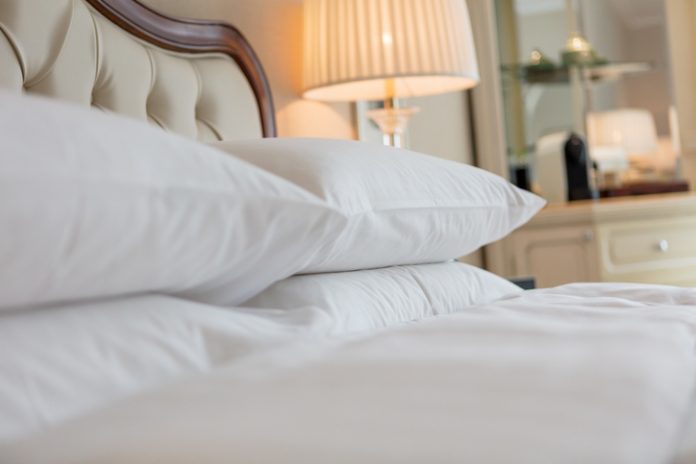
Bed bugs remain an expensive problem for America’s hospitality industry. A University of Kentucky study found that just one negative report of bed bugs on a travelers’ online review site can cost a 300-room hotel catering to business travelers $274,000 per month in revenue, and $166,000 per month for a similarly sized hotel catering to vacationing guests. These costs include the expense for pest control remediation, the loss of room revenue during the inspection and treatment process, guest compensation, and discarding of soft goods.
To prevent bed bug incidents and stop them from transitioning into infestations, housekeeping departments need to implement an awareness campaign to protect the health and comfort of their guests—and protect their properties against legal liabilities.
Daily Inspection for Bed Bugs
Housekeeping should spend the majority of their time searching mattresses, box springs, and any of the surrounding areas. These areas can include headboards, nightstands, lampshades, or any pictures hanging on walls.
Bed bugs are very flat and can slip between creases or often inside the stitching, tufting, and edges of a mattress. Box springs, especially the wooded support structure within the void on the underside of the dust cover, are notorious sites for bed bug harborage. Make sure to inspect the frame of the bed as well.
Other common areas to find bed bugs include the space between the headboard and adjoining wall, holes made by picture hooks, and the underside of drawers.
Tell-Tale Signs of Bed Bugs in Hotels
Adults are approximately the size of an apple seed, but juvenile forms and eggs may be more difficult to identify because of their small size. Another sign is if a guest approaches staff with overt bites or welts dispersed throughout their body. However, not all guests will show signs of bites and with some guests it may be days before a welt appears. Further, a medical practitioner cannot distinguish a bed bug bite from other insect bites.
Bed bug droppings, which can often look like black magic marker smudges on fabric surfaces, are yet another tell-tale sign of bed bugs, as are the presence of casts or molted skins. As bed bugs mature, they will shed their skin on multiple occasions.
Blood spattered linens can also clue hotel staff into the presence of bed bugs. Often a sleeping guest will unconsciously slap at a bed bug biting, resulting in a blood stain on the linens.
If any of these signs are noted, hotel management should contact a pest management professional (PMP) as soon as possible and quarantine the room. In the event an actual bed bug is found, try to preserve it in a sealed plastic bag for the PMP to examine. Unless there is an obvious positive sign of a bed bug, the PMP will provide either visual evidence and/or a positive alert via trained dog inspection.
If a room is determined to have bed bugs, best management practice suggests that the PMP thoroughly inspect the adjoining rooms beside, below, and above. Minimally, treat the adjoining walls, ceilings, and floors to slow migration from the target room.
Prevent Bed Bugs in Hotels
From both cost and reputation perspectives, bed bug prevention is far preferable than post-infestation treatment. In addition to the important inspection guidelines provided above, there are several proactive steps hospitality professionals can take to prevent the problem from occurring in the first place. The goal is to prevent the bed bug-guest encounter.
1Box Spring Platforms
Typical railed box spring frames full of nooks and crannies are common hiding places for bed bugs. Instead, use metal spring platforms that have minimal crevices.
2Dust Ruffles
Dust ruffles that cascade to the floor, especially highly ruffled and pleated ones, are an easy entrance ramp for bed bugs. A better choice is decorative fabric covers that fit snuggly around the box spring.
3Headboards
Up to 85 percent of bed bugs are found within a five-foot radius of the bed, with headboards being a common hiding place. Instead of upholstery with tufting and other crevices for bed bugs to hide, choose metal, wood, or wood composite designs with little to no textured areas. Simple is better. Pay attention to the backside of the headboard and how it is attached to the wall to reduce hot spots for bed bug activity.
4Luggage Racks
The straps on luggage racks often harbor bed bugs. A hard surface piece of furniture nearby, such as a low dresser, is a better alternative. If a hotel uses racks, take them out of the closet and place them in a prominent spot in the room where they’re openly available. Guests dropping suitcases on beds offer the most likely introduction of bed bugs.
5Preventive, Active Mattress Liners
Unlike an encasement that simply wraps around the bed and traps bed bugs inside, active mattress liners kill bed bugs and continue to protect guests for two years. As easy to install as a fitted sheet, these preventive liners render bed bugs no longer able to bite and females incapable of dropping their eggs within 10 minutes of contact. Most importantly, these liners have been proven to save more than 3,000-bed hotels over a half million dollars per year.
While stopping the introduction of bed bugs is not possible, preventing its development into an infestation is achievable through implementing proactive, preventive measures and continued vigilance.











